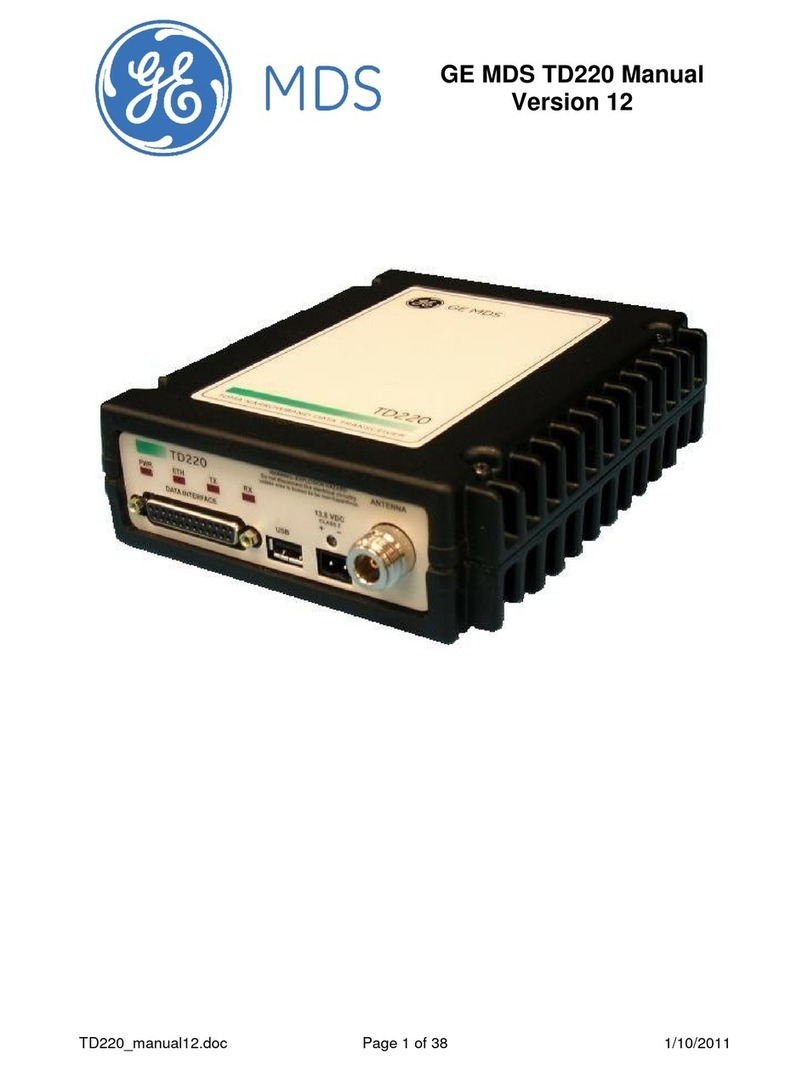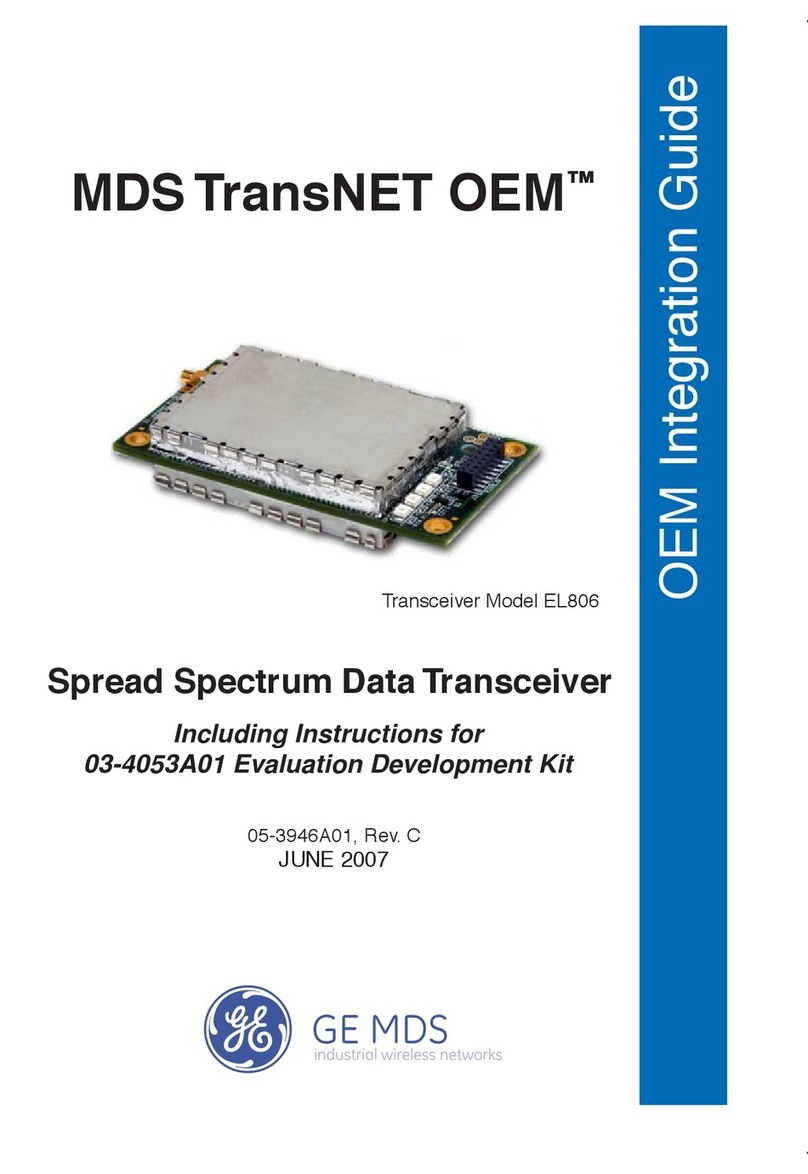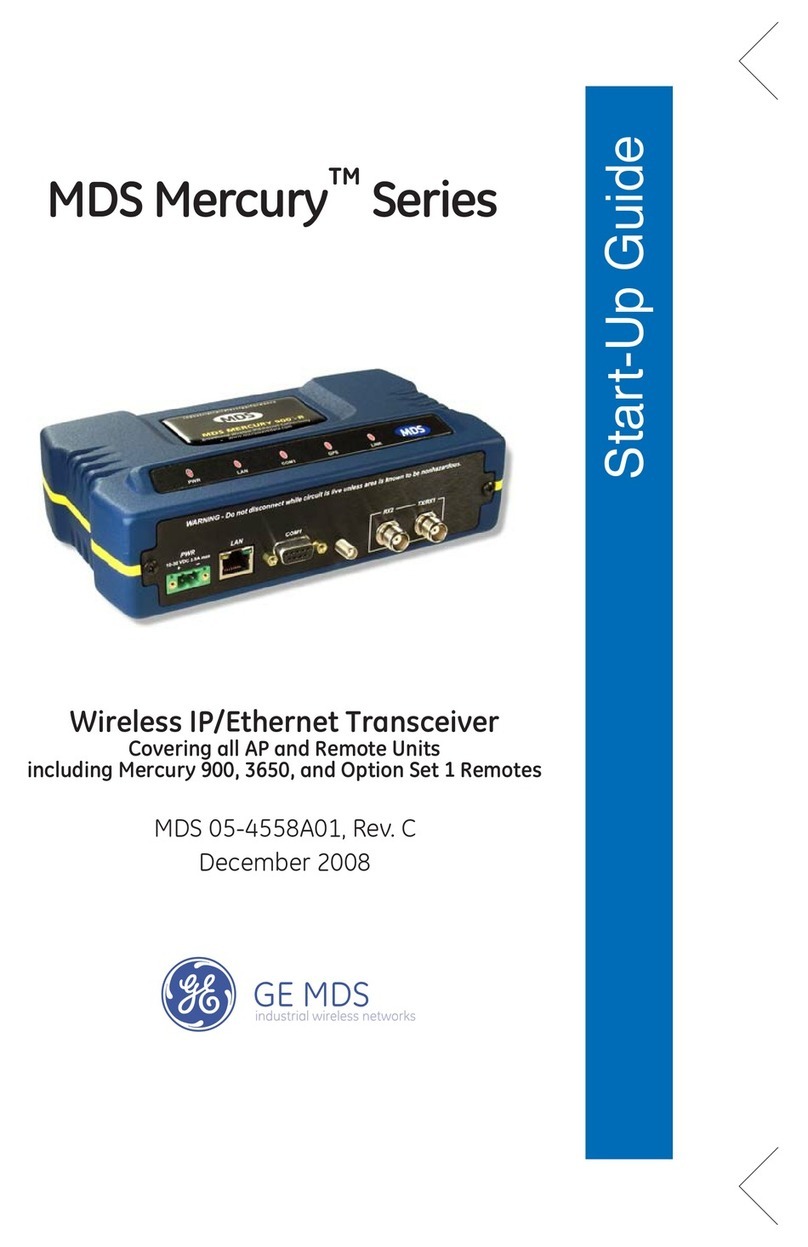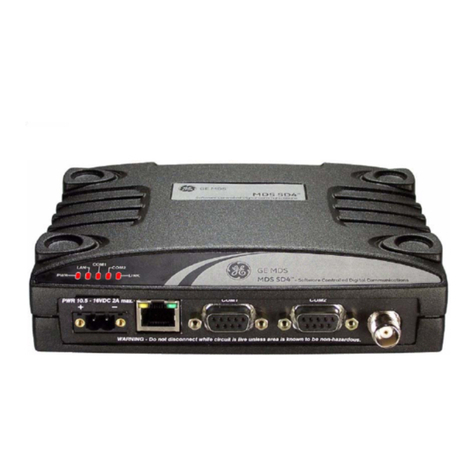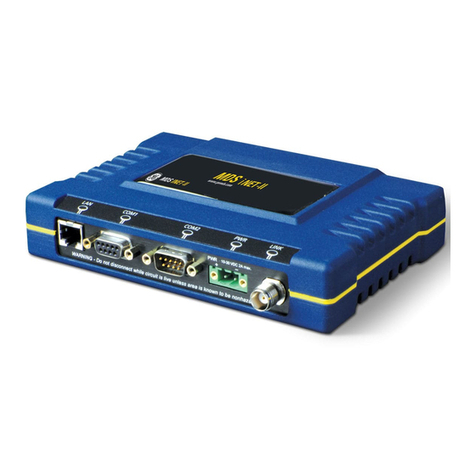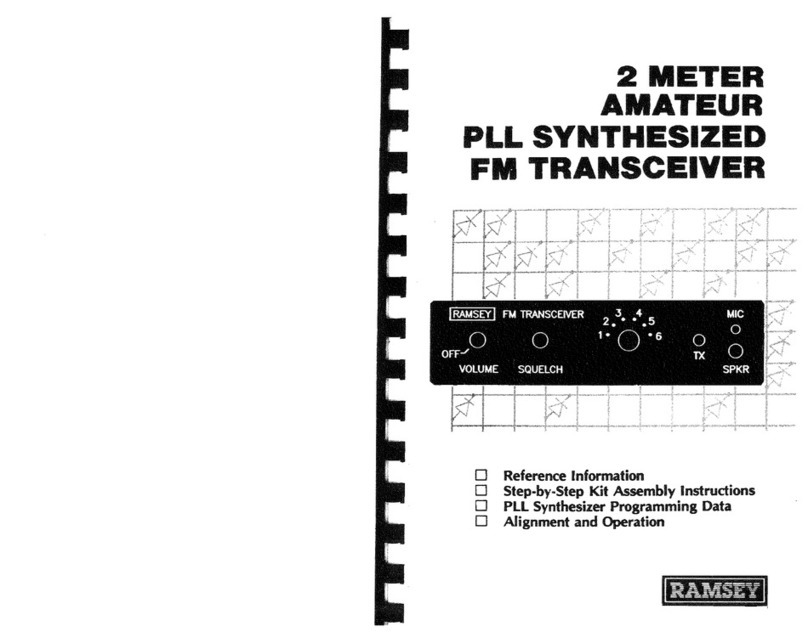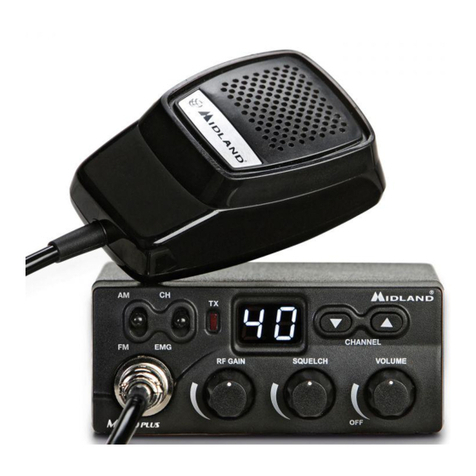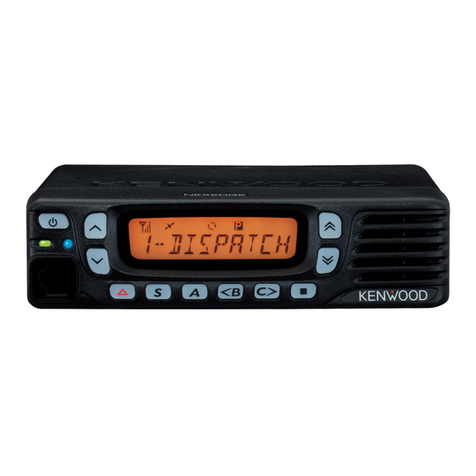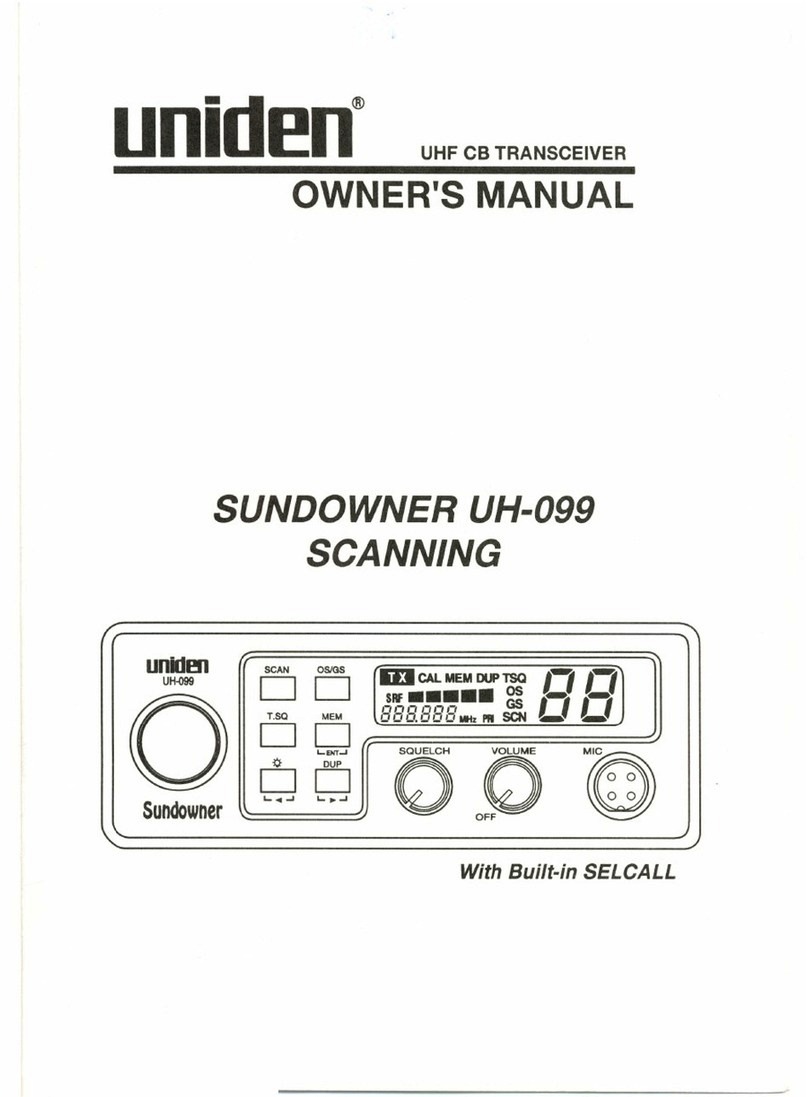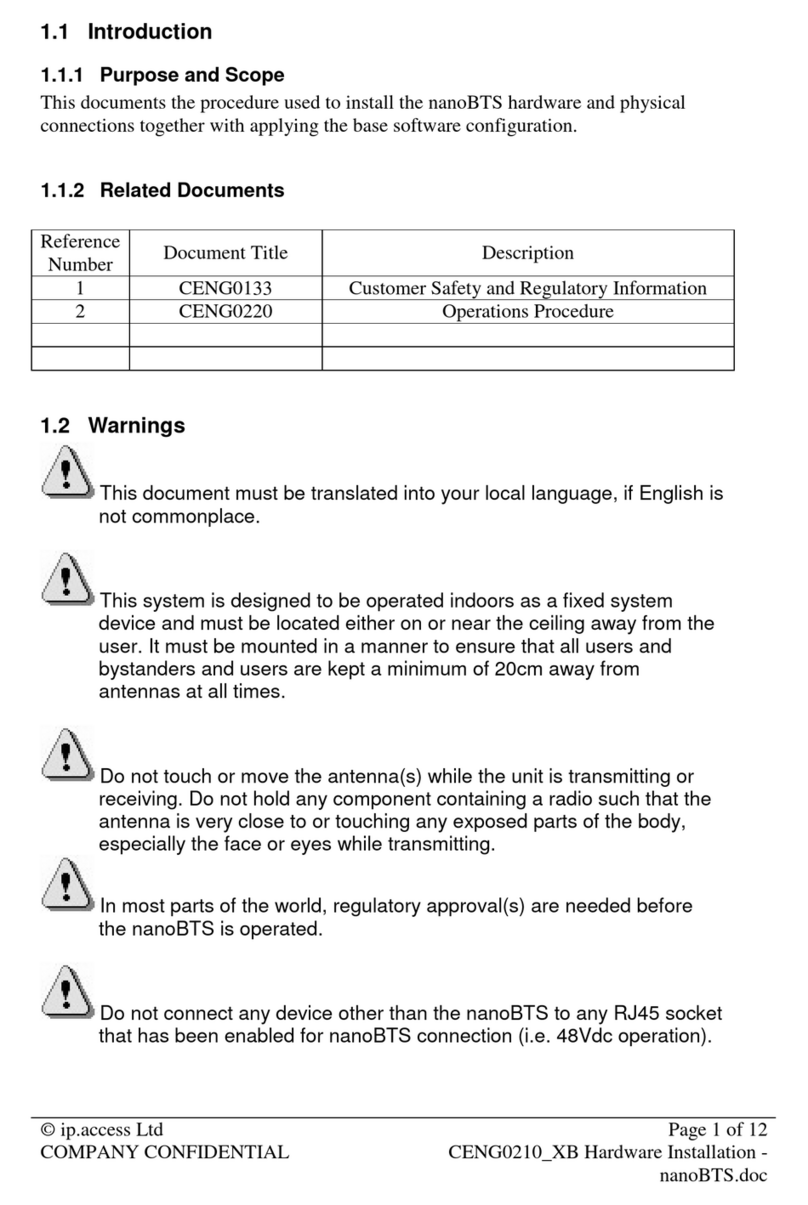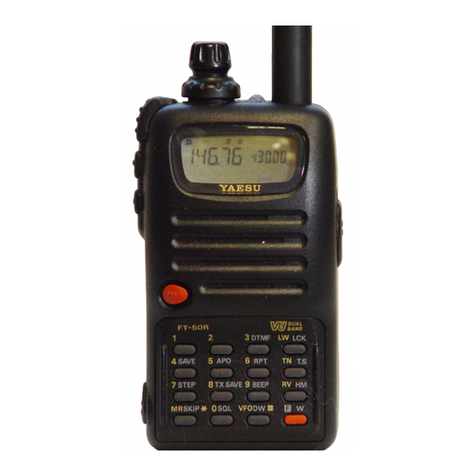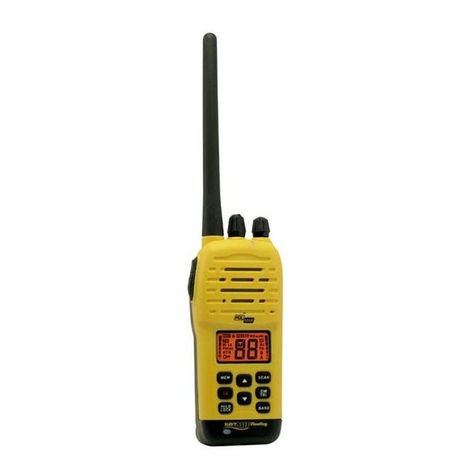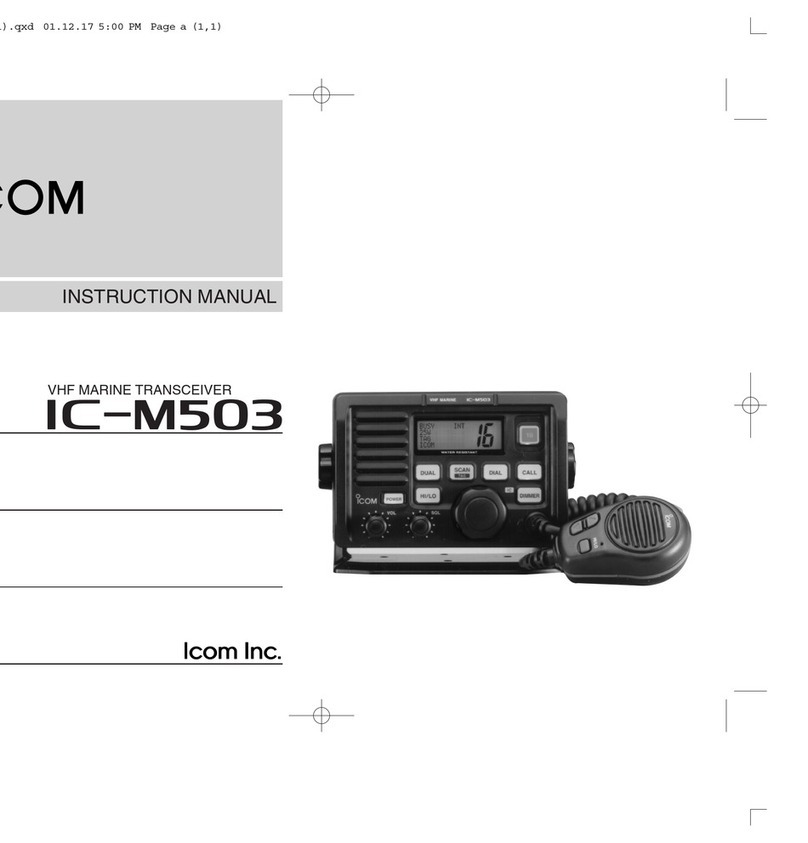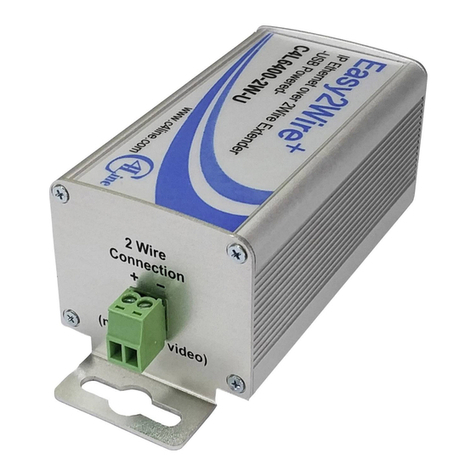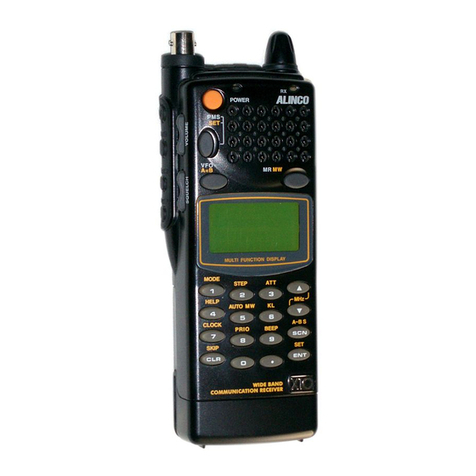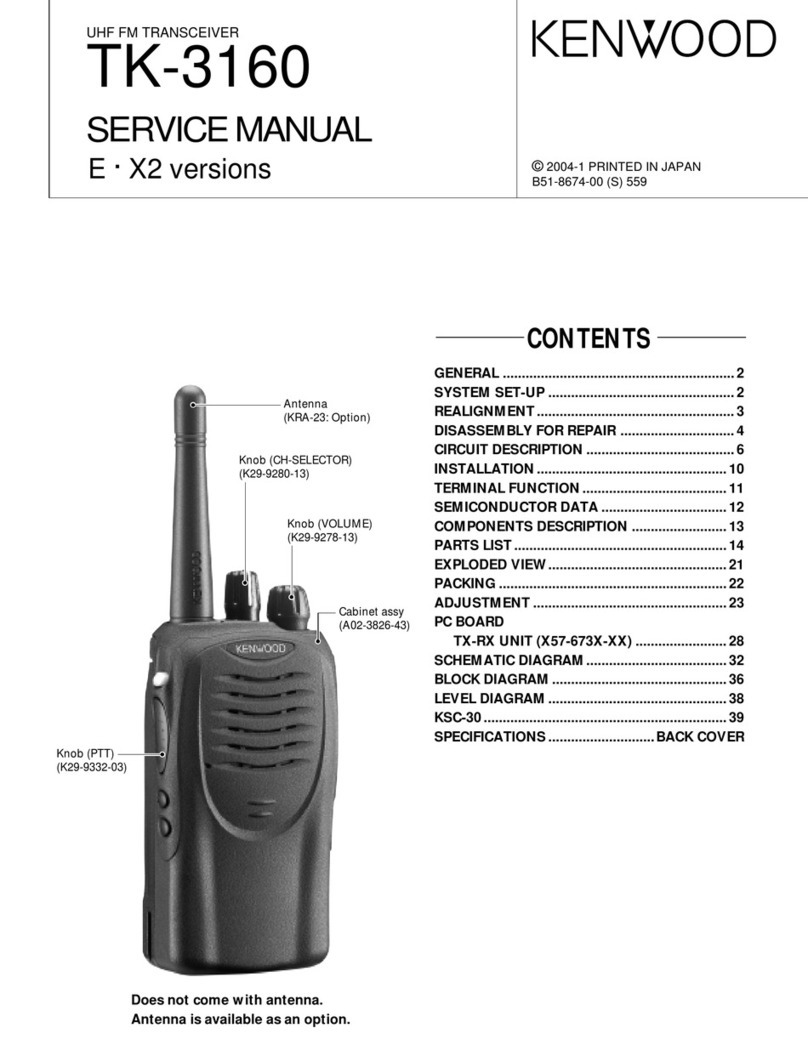GE MDS Mercury 900 User manual

Reference Manual
05-4446A01, Rev. E
MARCH 2009
Wireless IP/Ethernet Transceiver
Covering all AP and Remote Units
including Mercury 900, 3650, and Option Set 1 Remotes
MDS MercuryTM Series

05-4446A01, Rev. E Mercury Reference Manual i
TABLE OF CONTENTS
1 PRODUCT OVERVIEW & APPLICATIONS ............ 1
1.1 ABOUT THIS MANUAL................................................................................................... 3
1.1.1 Start-Up Guide .................................................................................................................... 3
1.1.2 Online Access to Manuals ................................................................................................... 3
1.1.3 Conventions Used in This Manual ....................................................................................... 3
1.2 PRODUCT DESCRIPTION............................................................................................. 4
1.2.1 Model Offerings ................................................................................................................... 6
1.2.2 Remote Radio with Option Set 1 .........................................................................................7
1.2.3 GE MDS P23 Protected Network (Redundant) Configuration ............................................. 8
1.2.4 External GPS PPS Option ................................................................................................... 9
1.3 APPLICATIONS ..............................................................................................................9
1.3.1 Mobile/Fixed Data System .................................................................................................. 9
1.3.2 Wireless LAN ..................................................................................................................... 10
1.3.3 Point-to-Point LAN Extension .............................................................................................11
1.3.4 Serial Radio Network Connectivity .....................................................................................11
1.3.5 Multiple Protocols and/or Services .....................................................................................11
1.3.6 Wireless LAN with Mixed Services .................................................................................... 12
1.3.7 Upgrading Older Wireless Network with Serial Interfaces ................................................. 13
1.4 NETWORK DESIGN CONSIDERATIONS.................................................................... 14
1.4.1 Extending Network Coverage with Repeaters ................................................................... 14
1.4.2 Protected Network Operation using Multiple APs .............................................................. 16
1.4.3 Collocating Multiple Radio Networks ................................................................................. 16
1.5 GE MDS CYBER SECURITY SUITE............................................................................ 17
1.6 ACCESSORIES ............................................................................................................ 19
2 TABLETOP EVALUATION & TEST SETUP ............. 21
2.1 OVERVIEW................................................................................................................... 23
2.2 STEP 1: CONNECT THE ANTENNA PORTS............................................................... 23
2.3 STEP 2: CONNECT THE PRIMARY POWER.............................................................. 24

ii Mercury Reference Manual 05-4446A01, Rev. E
2.4 STEP 3: CONNECT PC TO THE TRANSCEIVER ....................................................... 25
2.5 STEP 4: REVIEW TRANSCEIVER CONFIGURATION ................................................ 25
2.5.1 Getting Started .................................................................................................................. 25
2.5.2 Procedure .......................................................................................................................... 25
2.5.3 Basic Configuration Defaults ............................................................................................. 25
2.6 STEP 5: CONNECT LAN OR SERIAL DATA EQUIPMENT.......................................... 26
2.6.1 Option Set 1 Connectors ................................................................................................... 28
2.7 STEP 6: CHECK FOR NORMAL OPERATION ............................................................ 29
3 DEVICE MANAGEMENT......................................... 31
3.1 INTRODUCTION .......................................................................................................... 33
3.1.1 Differences in the User Interfaces .....................................................................................33
3.2 ACCESSING THE MENU SYSTEM ............................................................................. 35
3.2.1 Methods of Control ............................................................................................................ 36
3.2.2 PC Connection and Log In Procedures ............................................................................. 36
3.2.3 Navigating the Menus ........................................................................................................ 40
3.3 BASIC OVERVIEW OF OPERATION........................................................................... 42
3.3.1 Starting Information Screen ............................................................................................... 42
3.3.2 Main Menu ......................................................................................................................... 43
3.4 CONFIGURING NETWORK PARAMETERS ............................................................... 45
3.4.1 Network Configuration Menu .............................................................................................45
3.4.2 Ethernet Port Configuration Menu ..................................................................................... 56
3.4.3 Bridge Configuration .......................................................................................................... 58
3.4.4 SNMP Agent Configuration ................................................................................................ 58
3.4.5 AP Location Push Config Menu ......................................................................................... 60
3.4.6 SNTP Server Configuration ............................................................................................... 64
3.5 RADIO CONFIGURATION............................................................................................ 65
3.5.1 Radio Configuration Menu ................................................................................................. 65
3.5.2 Serial Port Configuration ................................................................................................... 76
3.6 MODBUS / TCP SERVER CONFIGURATION ............................................................. 88
3.6.1 Modbus/TCP in Mercury TransceiversAn Overview ...................................................... 88
3.6.2 Menu Selections ................................................................................................................ 89
3.7 SECURITY CONFIGURATION MENU ......................................................................... 92
3.7.1 Device Security Menu ....................................................................................................... 93

05-4446A01, Rev. E Mercury Reference Manual iii
3.7.2 Wireless Security Menu ..................................................................................................... 95
3.7.3 IEEE 802.1x Device Authentication ................................................................................... 97
3.7.4 Manage Certificates .......................................................................................................... 99
3.8 REDUNDANCY CONFIGURATION (AP ONLY) ......................................................... 102
3.9 GPS CONFIGURATION (REMOTE ONLY) ................................................................ 107
3.10 DEVICE INFORMATION MENU ............................................................................... 109
3.11 PERFORMANCE INFORMATION MENU..................................................................110
3.12 MAINTENANCE/TOOLS MENU ............................................................................... 123
3.12.1 Installing Firmware via TFTP ........................................................................................ 129
3.12.2 Auto Firmware Upgrade Menu (AP Only) ..................................................................... 138
3.13 PERFORMANCE OPTIMIZATION............................................................................ 140
3.13.1 Proper Operation and What to Look For ....................................................................... 143
4 TROUBLESHOOTING & RADIO
MEASUREMENTS.................................................. 147
4.1 TROUBLESHOOTING................................................................................................ 149
4.1.1 Interpreting the Front Panel LEDs ................................................................................... 149
4.1.2 Troubleshooting With the Embedded Management System ........................................... 150
4.1.3 Using Logged Operation Events ..................................................................................... 153
4.1.4 Alarm Conditions ............................................................................................................. 154
4.1.5 Correcting Alarm Conditions ............................................................................................ 155
4.1.6 Logged Events ................................................................................................................ 155
4.2 RADIO (RF) MEASUREMENTS ................................................................................. 157
4.2.1 Antenna System SWR and Transmitter Power Output .................................................... 157
4.2.2 Antenna Aiming (For Directional Antennas)...................................................................... 158
5 PLANNING A RADIO NETWORK ......................... 161
5.1 INSTALLATION PLANNING ....................................................................................... 163
5.1.1 General Requirements .................................................................................................... 163
5.1.2 Site Selection .................................................................................................................. 164
5.1.3 Terrain and Signal Strength ............................................................................................. 165
5.1.4 Antenna & Feedline Selection ......................................................................................... 165
5.1.5 How Much Output Power Can be Used? ........................................................................ 169
5.1.6 Conducting a Site Survey ................................................................................................ 169
5.1.7 A Word About Radio Interference .................................................................................... 170

iv Mercury Reference Manual 05-4446A01, Rev. E
5.1.8 ERP Compliance at 900 MHz .......................................................................................... 172
5.1.9 ERP Compliance at 3650 MHz ........................................................................................ 173
5.2 dBm-WATTS-VOLTS CONVERSION CHART............................................................ 174
6 TECHNICAL REFERENCE.................................... 175
6.1 DATA INTERFACE CONNECTORS ........................................................................... 177
6.1.1 LAN Port .......................................................................................................................... 177
6.1.2 COM1 Port ...................................................................................................................... 177
6.2 SPECIFICATIONS ...................................................................................................... 178
6.3 NOTES ON SNMP...................................................................................................... 180
6.3.1 Overview ......................................................................................................................... 180
7 GLOSSARY OF TERMS & ABBREVIATIONS...... 185
Copyright Notice
This publication is protected by U.S.A. copyright law. Copyright 2009, GE MDS. All rights
reserved.
ISO 9001 Registration
GE MDS adheres to the internationally-accepted ISO 9001 quality system standard.
To our Customers
We appreciate your patronage. You are our business. We promise to serve and anticipate your
needs. We will strive to give you solutions that are cost effective, innovative, reliable and of the
highest quality possible. We promise to build a relationship that is forthright and ethical, one that
builds confidence and trust.
Related Materials on the Internet
—
Data sheets, frequently asked questions, case studies, applica-
tion notes, firmware upgrades and other updated information is available on the GE MDS Web site
at www.GEmds.com.
About GE MDS
Over two decades ago, GE MDS began building radios for business-critical applications. Since
then, we have installed thousands of radios in over 110 countries. To succeed, we overcame
impassableterrain, brutal operating conditions and disparate, complex networkconfigurations. We
also became experts in wireless communication standards and system applications worldwide. The
result of our efforts is that today, thousands of utilities around the world rely on GE MDS-based
wireless networks to manage their most critical assets.

05-4446A01, Rev. E Mercury Reference Manual v
The majority of GE MDS radios deployed since 1985 are still installed and performing within our
customers' wireless networks. That’s because we design and manufacture our products in-house,
according to ISO 9001 which allows us to control and meet stringent global quality standards.
Thanks to our durable products and comprehensive solutions, GE MDS is the wireless leader in
industrial automation
—
including oil and gas production and transportation, water/wastewater
treatment, supply and transportation, electric transmission and distribution and many other utility
applications. GE MDS is also at the forefront of wireless communications for private and public
infrastructure and online transaction processing. Now is an exciting time for GE MDS and our cus-
tomers as we look forward to further demonstrating our abilities in new and emerging markets.
As your wireless needs change you can continue to expect more from GE MDS. We'll always put
the performance of your network above all. Visit us at www.GEmds.com for more information.
OPERATIONAL & SAFETY NOTICES
Professional installation required. The radio equipment described in this
guide emits radio frequency energy. Although the power level is low, the
concentrated energy from a directional antenna may pose a health hazard.
Do not allow people to come closer than 23 cm (9 inches) to the antenna
when the transmitter is operating in indoor or outdoor environments. More
information on RF exposure is on the Internet at
www.fcc.gov/oet/info/documents/bulletins
.
To meet co-location requirements, the FCC requires a 20cm (7.87 inch)
separation distance between the unit’s WIFI and fundamental antenna
installations. See
“ERP Compliance at 900 MHz”
on Page 172 for allow-
able power/antenna settings for this radio.
Professional installation required. The transceiver described here emits
radio frequency energy. Although the power level is low, the concentrated
energy from a directional antenna may pose a health hazard. Do not allow
people to come closer than 22 cm (8.7 inches) to the antenna when the
transmitter is operating. This calculation is based on an 18 dBi panel
antenna. Refer also to the table below, which lists required separation dis-
tances. Additional information on RF exposure is available on the Internet
at www.fcc.gov/oet/info/documents/bulletins. See
“ERP Compliance at
3650 MHz”
on Page 173 for allowable power/antenna settings for this
radio.
To meet co-location requirements, the FCC requires a 20cm (7.87 inch)
separation distance between the unit’s WIFI and fundamental antenna
installations.
RF Exposure
(900 MHz models)
RF Exposure
(3650 MHz models)

vi Mercury Reference Manual 05-4446A01, Rev. E
CSA/
us
Notice (Remote Transceiver Only)
This product is approved for use in Class 1, Division 2, Groups A, B, C & D Hazardous Locations. Such locations are
defined in Article 500 of the National Fire Protection Association (NFPA) publication
NFPA 70
, otherwise known as
the National Electrical Code.
The transceiver has been recognized for use in these hazardous locations by the Canadian Standards Association
(CSA) which also issues the US mark of approval (CSA/
US
). The CSA Certification is in accordance with CSA STD
C22.2 No. 213-M1987.
CSA Conditions of Approval: The transceiver is not acceptable as a stand-alone unit for use in the
hazardous locations described above. It must either be mounted within another piece of equipment
which is certified for hazardous locations, or installed within guidelines, or conditions of approval,
as set forth by the approving agencies. These conditions of approval are as follows:
The transceiver must be mounted within a separate enclosure which is suitable for the intended
application.
The antenna feedline, DC power cable and interface cable must be routed through conduit in accor-
dance with the National Electrical Code.
Installation, operation and maintenance of the transceiver should be in accordance with the trans-
ceiver's installation manual, and the National Electrical Code.
Tampering or replacement with non-factory components may adversely affect the safe use of the
transceiver in hazardous locations, and may void the approval.
A power connector with screw-type retaining screws as supplied by GE MDS must be used.
Do not disconnect equipment unless power has been switched off or the area is known to
be non-hazardous.
Refer to Articles 500 through 502 of the National Electrical Code (NFPA 70) for further
information on hazardous locations and approved Division 2 wiring methods.
FCC Part 15 Notices
The transceiver series complies with Part 15 of the FCC Rules. Operation is subject to the fol-
lowing two conditions: (1) this device may not cause harmful interference, and (2) this device must
accept any interference received, including interference that may cause undesired operation. This
device is specifically designed to be used under Section 15.247 of the FCC Rules and Regulations.
Any unauthorized modification or changes to this device without the express approval of Micro-
wave Data Systems may void the user’s authority to operate this device. Furthermore, the Mercury
Series is intended to be used only when installed in accordance with the instructions outlined in
this manual. Failure to comply with these instructions may also void the user’s authority to operate
this device.
Part15 rulesalso requirethat theEffective IsotropicRadiated Power(EIRP) froma Mercury Series
900 MHz installation not exceed 36 dBm. For the Mercury 3650, EIRP must not exceed 1-watt per
MHz. Refer to this manual for more information.
EXPLOSION
HAZARD!

05-4446A01, Rev. E Mercury Reference Manual vii
Industry Canada RSS Notices
Operation is subject to the following two conditions: (1) this device may not cause interference,
and (2) this device must accept any interference, including interference that may cause undesired
operation of the device.
To reduce potential radio interference to other users, the antenna type and its gain should be chosen
so that the Equivalent Isotropic Radiated Power (EIRP) is not more than that permitted for suc-
cessful communication.
This device has been designed to operate with the antennas listed in this manual. Antennas not
included here are strictly prohibited for use with this device. The required antenna impedance is 50
ohms.
Manual Revision and Accuracy
This manual was prepared to cover a specific version of firmware code. Accordingly, some screens
and features may differ from the actual unit you are working with. While every reasonable effort
has been made to ensure the accuracy of this guide, product improvements may also result in minor
differences between the manual and the product shipped to you. If you have additional questions
or need an exact specification for a product, please contact our Customer Service Team using the
information at the back of this guide. In addition, manual updates can often be found on the GE
MDS Web site at www.GEmds.com.
Environmental Information
The manufacture of this equipment has required the extraction and use of natural resources.
Improper disposal may contaminate the environment and present a health risk due to hazardous
substancescontained within. To avoid disseminationof these substances into our environment, and
to limit the demand on natural resources, we encourage you to use the appropriate recycling sys-
temsfor disposal.These systems will reuse or recycle most of thematerials foundin this equipment
in a sound way. Please contact GE MDS or your supplier for more information on the proper dis-
posal of this equipment.

viii Mercury Reference Manual 05-4446A01, Rev. E

05-4446A01, Rev. E Mercury Reference Manual 1
1
PRODUCT OVERVIEW
AND APPLICATIONS
1 Chapter Counter Reset Paragraph
Contents
1.1 ABOUT THIS MANUAL ......................................................... 3
1.1.1 Start-Up Guide ....................................................................... 3
1.1.2 Online Access to Manuals ...................................................... 3
1.1.3 Conventions Used in This Manual ......................................... 3
1.2 PRODUCT DESCRIPTION ................................................... 4
1.2.1 Model Offerings ...................................................................... 6
1.2.2 Remote Radio with Option Set 1 ............................................ 7
1.2.3 GE MDS P23 Protected Network (Redundant) Config. ......... 8
1.2.4 External GPS PPS Option ..................................................... 9
1.3 APPLICATIONS ..................................................................... 9
1.3.1 Mobile/Fixed Data System ..................................................... 9
1.3.2 Wireless LAN ......................................................................... 10
1.3.3 Point-to-Point LAN Extension ................................................ 11
1.3.4 Serial Radio Network Connectivity ......................................... 11
1.3.5 Multiple Protocols and/or Services ......................................... 11
1.3.6 Wireless LAN with Mixed Services ......................................... 12
1.3.7 Upgrading Older Wireless Network with Serial Interfaces ..... 13
1.4 NETWORK DESIGN CONSIDERATIONS ............................ 14
1.4.1 Extending Network Coverage with Repeaters ....................... 14
1.4.2 Protected Network Operation using Multiple APs .................. 16
1.4.3 Collocating Multiple Radio Networks ..................................... 16
1.5 GE MDS CYBER SECURITY SUITE .................................... 17
1.6 ACCESSORIES..................................................................... 19

2 Mercury Reference Manual 05-4446A01, Rev. E

05-4446A01, Rev. E Mercury Reference Manual 3
1.1 ABOUTTHIS MANUAL
This
Reference Manual
is one of two publications provided for users of
the Mercury Series
TM
transceiver system. It contains detailed product
information, an overview of common applications, a screen-by-screen
review of the menu system, technical specifications, suggested settings
for various scenarios, and troubleshooting information. This manual
should be available to all personnel responsible for network design,
setup, commissioning and troubleshooting of the radios.
1.1.1 Start-Up Guide
The Mercury Series
Start-Up Guide
(Part No. 05-4558A01) is a com-
panion publication to the Reference Manual. It is a smaller book, with a
specific purpose—to guide an installer in the basic steps for getting a
transceiver on the air and communicating with other units in a network.
It provides only the essential information installers need for getting their
equipment up and running in the shortest time possible.
1.1.2 Online Access to Manuals
In addition to printed manuals, many users need access to documents
electronically. This is especially useful when you need to access docu-
mentation while traveling, or want to share a document with another
user in the field. Electronic documents also allow searching for a spe-
cific term or subject, especially in larger manuals.
Access manuals for our equipment anytime from our Web site at
www.GEmds.com
. Simply click the
Downloads
tab at the top of the home
page and select
Product Manuals
from the drop-down list. A search
window appears to help you locate the manual you need.
Online manuals are provided as PDF files in the Adobe
®
Acrobat
®
stan-
dard. If necessary, download the free reader for PDF files from
www.adobe.com
.
1.1.3 Conventions Used in This Manual
On-Screen Menu Items
On-screen menu items or command entries are presented in a distinctive
font to set them apart from regular text (for example: Network Name, IP
Address, Password). You will find this font most often in Chapter 3,
where the menu system is discussed in detail. When variable settings or
a range of options are available for a menu option, the items are pre-
sented inside brackets, with the default setting (if any) shown last after
a semicolon:
[available settings or range; default setting]

4 Mercury Reference Manual 05-4446A01, Rev. E
Menu Strings
To help show the path to a menu selection, navigation strings are used
in several places in this manual. For example, suppose you want to view
or set the Network Name assigned to your system. This item is located
in the Network Configuration Menu, so the navigation string in the text
would appear as shown:
Main Menu>>Network Configuration>>Network Name
By following this order of menus, you can quickly reach the desired
menu.
1.2 PRODUCT DESCRIPTION
The GE MDS Mercury SeriesTM transceiver (Figure 1-1) is an
easy-to-install wireless solution offering extended range, secure opera-
tion, and multi-megabit performance in a compact and rugged package.
The transceiver is ideally suited for demanding applications in fixed or
mobile environments, where reliability and range are paramount.
The transceivers are commonly used to convey text documents,
graphics, e-mail, video, Voice over IP (VoIP), and a variety of other
application data between mobile, fixed-point, and WAN/LAN-based
entities.
Based on multi-carrier Orthogonal Frequency Division Multiplexing
(OFDM), the transceiver features high speed/low latency, basic Quality
of Service (QoS) for prioritizing traffic, Ethernet and serial encapsula-
tion, and network roaming. It also provides enhanced security features
including AES encryption and IEEE 802.1x Device Authentication,
making the Mercury system the best combination of security, range, and
speed of any industrial wireless solution on the market today.
Invisible place holder
Figure 1-1. The GE MDS Mercury SeriesTM Transceiver
(Remote unit shown, AP similar in appearance)
Rugged Packaging The transceivers are housed in a compact and rugged die cast-aluminum
casethat needs only protection from direct exposureto the weather. This

05-4446A01, Rev. E Mercury Reference Manual 5
oneenclosurecontains all necessarycomponents for radiooperation and
data communications.
Simple Installation Mercury Transceivers are designed for rapid and trouble-free installa-
tion. For basic services, you simply connect the antennas (900 or 3650
MHz as required, and GPS), connect your data equipment, apply pri-
mary power, and set some operating parameters. No license is required
for 900 MHz operation in the USA, Canada, and many other countries.
A simple registration process is required for 3650 MHz operation in the
USA. Check requirements for your region before placing the equipment
into service. (NOTE: 3650 MHz is for APs and Fixed Remote stations.)
Most installations employ an omni-directional antenna at the Access
Point (AP) location and mobile stations. Fixed Remote stations often
employ a directional antenna aimed at the AP. Regardless of the type
used, antennas are a vital part of the system and must be chosen and
installed correctly. Refer to INSTALLATION PLANNING on Page 163
for guidance on choosing suitable antennas and installation sites.
Secure Operation Data network security is a vital issue in today’s wireless world. Mercury
transceivers provide multiple tools to help you build a network that min-
imizes the risk of eavesdropping and unauthorized access. Some are
inherent in the radio’s operation, such as the use of 900 MHz
spread-spectrum transmissions; others include AES data encryption,
enabling/disabling channels, IEEE 802.1X port blocking, approved
device lists, secure devices management protocols, and password pro-
tection.
Security is not a one-step process that can simply be turned on and for-
gotten. It must be practiced and enforced at multiple levels,
24 hours-a-day and 7 days-a-week. See “GE MDS CYBER SECURITY
SUITE” on Page 17 for more information about the transceiver’s secu-
rity tools.
Robust Radio
Operation The transceivers are designed for operation in the 900 MHz license-free
Industrial, Scientific, and Medical (ISM) band and the 3650-3700 MHz
registered band. They provide consistent, reliable coverage over a large
geographic area.
Mobile range depends on many factors, including terrain, building den-
sity, antenna gain, and speed of travel. The unit is designed for suc-
cessful application in a variety of mobile environments, and offers the
best combination of range, speed and robustness available in an indus-
trialwirelesspackage today. Byusingmultiple Access Points,anetwork
can be created that provides consistent, reliable coverage over a large
metropolitan area. See “SPECIFICATIONS” on Page 178 for more
information on transmission range.
Flexible Services Userswith a mix of equipment having Ethernet and serialdata interfaces
can use this equipment via a Remote transceiver. The transceiver pro-
vides services in data networks that are migrating from legacy

6 Mercury Reference Manual 05-4446A01, Rev. E
serial/EIA-232-based hardware to the faster and more easily interfaced
Ethernet protocol.
Flexible
Management You can locally or remotely configure, commission, troubleshoot, and
maintain the transceiver. Four different modes of access are available:
local RS-232 console terminal, local or remote IP access (via Telnet or
SSH), web browser (HTTP, HTTPS), and SNMP (v1/v2/v3) All IP
accessinterfacesare available throughtheunit’s wired Ethernetport and
over the air.
The text-based interfaces (RS-232 console, Telnet, and SSH) are imple-
mented in the form of easy-to-follow menus, and the terminal server
provides a wizard to help you configure the units correctly.
Transceiver
Features The transceiver’s design makes the installation and configuration easy,
while allowing for future changes.
• Industrial-Grade Product—Extended temperature range for
trouble-free operation in extreme environments.
• RobustRadioCommunications—Designedtooperateoverlong
distances in dense, high-interference environments.
• Robust Network Security—Prevents common attack schemes
and hardware from gaining access or control of the network.
Common attack events are logged and reported by alarms.
• Transmission Speed—Operation at 1.5 Mbps is over 100-times
faster than 9.6 kbps radios.
• Plug-and-Play Connectivity—AP or Remote configuration
requires minimal setup.
• Built-in GPS Receiver—GPS technology is used for timing and
location data. The only external equipment needed for this func-
tionality is a GPS antenna available from GE MDS).
1.2.1 Model Offerings
The transceiver comes in two primary models—Access Point and
Remote.Unique hardwareis used for each model. Of theRemote radios,
there are two sub-types available—Standard Remote and Remote
with Option Set 1, both of which support Ethernet and serial services.
Table 1-1 summarizes each radio’s interface services.
Table 1-1. Transceiver Models and Data Interface Services
Model Sub-Type Ethernet/LAN1COM11USB Integrated WiFi
Access Point N/A Yes Yes No No
Remote Standard Remote Yes Yes No No
Remote w/Option Set 1 Yes Yes Yes Yes
NOTES
1. COM1 provides access to the embedded Management System for all units.

05-4446A01, Rev. E Mercury Reference Manual 7
Available Frequency Bands
At the time of publication, Mercury transceivers are offered in two dif-
ferent frequency bands: 902-928 MHz (Mercury 900) and 3.65–3.70
GHz (Mercury 3650). The 900 MHz unit operates in a license-free spec-
trum (frequency hopping spread spectrum—FHSS), which may be used
by anyone in the USA, provided FCC Part 15 rules are observed.
Canada, and certain other countries allow license-free operation in this
band—check your country’s requirements.
The 3.65–3.70 GHz radio operates in a “registered” band using conten-
tion-based protocol, which provides additional protection from interfer-
ence, but it requires FCC registration before operation can begin. Other
restrictions may apply based on your location and “grandfathered” FSS
users. Check local requirements before operation. GE MDS has pub-
lished a whitepaper containing frequently asked questions about the
3.65–3.70 GHz band. To obtain a copy, request publication
05-4734A02. (NOTE: 3650 MHz is for APs and Fixed Remote stations.)
Operationally, the Mercury 3650 has two key differences from the Mer-
cury 900: First, it operates on a different RF band (3.65–3.70 GHz).
Second, it only requires GPS for TDD synchronization of the Access
Points, which may or may not be needed for an installation.
Access Point or Remote?—Identification Tip
The outward appearance of AP and Remote radios is nearly identical,
however, the hardware for each type is different and they are not inter-
changeable. An quick way to identify them is to observe the color of the
gasket seal in the center of the radio case. APs have a black gasket,
while Remote units have a yellow gasket.
In addition to gasket color, a label on the top of each radio identifies it
as an AP or Remote unit. If the label shows an –A suffix, it is an AP. If
it shows a –R suffix, it is a Remote.
1.2.2 Remote Radio with Option Set 1
The “Option Set 1” Remote is similar to and compatible with the stan-
dard Mercury Remote. It contains the same 900 MHz radio, user inter-
face, and primary functionality as the Standard Remote. The Standard
Remote can be directly replaced with the Option Set 1 Remote. The key
differences are the additional physical interfaces: an IEEE 802.11b/g
WiFi networking module, a USB device port, a USB host port, and a
second Ethernet port on the radio enclosure.
The USB ports are used for device management. The host port accepts
a flash drive and can be used to transfer firmware and configuration
files. The two Ethernet ports are connected to an internal, integrated
switch and included in the Layer 2 bridge.

8 Mercury Reference Manual 05-4446A01, Rev. E
The internal WiFi module has FCC modular approval and may only be
operated by connecting one of the GE MDS approved antennas (see
802.11 WiFi Module Specifications below) to the reverse-SMA con-
nector on the radio’s front panel. Only these antennas may be used. The
WiFi module can operate as an 802.11 Access Point or Infrastructure
Station, according to user configuration. The operational mode (AP, Infra-
structure RM) and frequency can be configured through the unit's user
interface.
Invisible place holder
Figure 1-2. Mercury Remote with Option Set 1
(Note interface connector differences from Standard Remote)
802.11 WiFi Module Specifications
The specifications listed below are unique to Remotes with Option Set
1, which contain a 2.4 GHz WiFi module. SPECIFICATIONS on
Page 178 contains a complete list of general Mercury Series specifica-
tions.
Protocol: IEEE 802.11b/g OFDM 6 to 54Mbps, CCK 1 to
11Mbps
Frequency Range: 2400 to 2500MHz
Maximum Transmit Power: 15 dBm
Permissible Antennas: MDS 97-4278A36
MDS 97-4278A34
MDS 97-4278A35
FCC: Part 15C
FCC ID: VRA-SG9011028
WiFi Antenna Connector: Female Reverse SMA
1.2.3 GE MDS P23 Protected Network (Redundant)
Configuration
For mission-critical applications, a Protected Network Station is also
offered. This unit incorporates two Access Points, two power supplies,
and a switchover logic board that automatically selects between Trans-
ceiver A and Transceiver B as the active radio. Figure 1-3 shows the

05-4446A01, Rev. E Mercury Reference Manual 9
protected chassis. For system-level information on this product, refer to
MDS publication 05-4161A01.
Invisible place holder
Figure 1-3. MDS P23 Protected Network Station
(incorporates two transceivers, with automatic switchover)
1.2.4 External GPS PPS Option
The External GPS Precise Positioning Service (PPS) option allows for
an external GPS device to provide the PPS input to the Mercury. This is
useful in installations where multiple radios require GPS timing. This
option prevents each Mercury from requiring its own GPS antenna.
Refer to the electrical specifications in the External GPS PPS Option
section on Page 180. This option is only available in hardware revision
1.0.2 or later.
1.3 APPLICATIONS
The following sections provide illustrations of typical transceiver instal-
lations. This is an overview only. A Network Administrator should be
involved in all installation planning activities.
1.3.1 Mobile/Fixed Data System
Mercury transceivers support high-speed data communications in a
mobileenvironment. In this application, Remoteradios “roam” between
different Access Points, providing seamless transitions and continuous
coverage throughout a municipal area. Figure 1-4 shows an example of
an integrated system employing both mobile and fixed Mercury trans-
ceivers.
NOTE: 3650 MHz is for APs and Fixed Remote stations only.

10 Mercury Reference Manual 05-4446A01, Rev. E
Invisible place holder
Figure 1-4. Integrated Mobile/Fixed Application
1.3.2 Wireless LAN
ThewirelessLAN isa common applicationof the transceiver.It consists
of a central control station (Access Point) and one or more associated
Remoteunits,asshowninFigure 1-5. A LAN providescommunications
between a central WAN/LAN and remote Ethernet segments. The oper-
ation of the radio system is transparent to the computer equipment con-
nected to the transceiver.
The Access Point is positioned at a location from which it communi-
cates with all Remote units in the system. Commonly, this is a high loca-
tion on top of a building or communications tower. Messages are
exchanged at the Ethernet level. This includes all types of IP traffic.
A Remote transceiver can only communicate over-the-air to an Access
Point (AP). Peer-to-peer communications between Remotes can only
take place indirectly via the AP. In the same fashion, an AP can only
communicate over-the-air to associated Remote units. Exception: Two
APs can communicate with each other “off-the-air” through their
Ethernet connectors using a common LAN/WAN.
Invisible place holder
Figure 1-5. Typical Wireless LAN
MDS 4790
Master Radio
Licensed Serial/IP Integration
Mercury AP
MDS 4710
RTU/PLC
(Serial)
RS-232
RS-232
RS-232
MDS 4710
RTU/PLC
(Serial)
RTU/PLC
(Ethernet)
Long Range WLAN
Mobile DataMobile Data
MDS NETview MS®
Server
(Ethernet)
Computer Router
WAN
Video
Surveillance
Mercury
remote
Control Center Mercury
remote
Mercury
remote
Mercury
remote
R
emo
t
e
Remote
Access Point
Remote
Remote
LAN
LAN
WAN/LAN
LAN
LAN

05-4446A01, Rev. E Mercury Reference Manual 11
1.3.3 Point-to-Point LAN Extension
A point-to-point configuration (Figure 1-6) is a simple arrangement
consisting of an Access Point and a Remote unit. This provides a com-
munications link for transferring data between two locations.
Invisible place holder
Figure 1-6. Typical Point-to-Point Link
1.3.4 Serial Radio Network Connectivity
The transceiver provides a path for serial devices to migrate to
IP/Ethernet systems. Many radio networks in operation today still rely
on serial networks at data rates of 9600 bps or less. These networks can
use the transceiver as a means to continue using the serial service, while
allowing the infrastructure to migrate to an IP format.
A Remote transceiver with its serial port connected to a GE MDS
serial-based radio, such as the MDS x790/x710, MDS TransNET and
others, provides a path for bringing the data from the older radio into the
IP/Ethernet environment of a Mercury-based system.
Invisible place holder
Figure 1-7. Backhaul Network
1.3.5 Multiple Protocols and/or Services
Prior to the introduction of Ethernet/IP-based radios, two radios were
often used to service two different types of devices (typically connected
LAN/WAN
Access Point Remote
LAN
MDS 4790
Master
MDS 9790
Master
MDS 9810
Master
Serial Conn.
Serial Conn.
Serial Conn.
MDS 4710 Remote
NMS Control
Point
SCADA Host
Modbus/IP
HUB Access Point
MDS 4710 Remote
MDS 9710 Remote
MDS 9710 Remote
MDS 9810 Remote
MDS 9810 Remote
Remote Serial
Remote Serial
Remote Serial
NETWORK
ROUTER
ROUTER
Serial
Device
Serial
Device
Serial
Device
Serial
Device
Serial
Device
Serial
Device
This manual suits for next models
2
Table of contents
Other GE MDS Transceiver manuals
